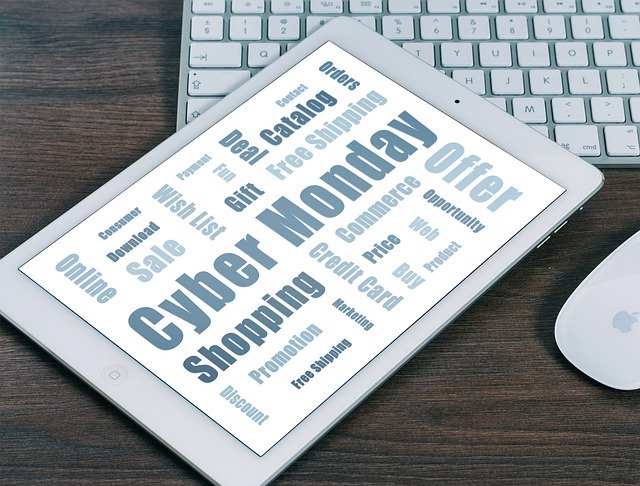It’s Cyber Monday, and consumers are sweeping the internet for deals on the gifts and merchandise they want this holiday season. This year, online shopping is well underway, with Yahoo Finance reported that as of 9 a.m. on Black Friday, online sales were tracking about 19 percent higher than 2018. In addition, Thanksgiving online sales exceeded $4 billion online for the first time in history.
If your end-of-day report didn’t reflect that kind of e-commerce sales growth, consider these tips that help you increase online activity in the last few weeks of the year:
Make digital offers
To bring people into a physical store, you may have used newspaper inserts, print ads, or broadcast. E-commerce shoppers, however, may not be reading newspapers or tuning into local television or radio stations. They are online. Digital marketing, including email and text offers, in-app advertising, pay-per-click ads, and social marketing, is an effective way to reach online shoppers. It can be an especially beneficial strategy if you segment your customer base so that you can target clients with ads that will appeal to them based on their purchase histories or their demographics.
Just as with sales and promotions for in-store shoppers, digital offers also need to have a sense of urgency — Cyber Monday-only deals are a great example. But unlike mailers, print ads, or inserts that you may send out only once or twice, you need to send digital offers with more frequency to boost e-commerce sales. There is a lot of competition trying to get your customers’ business — make sure they see your brand and the offers you are making.
Leverage your loyalty program
If you’re wondering where to get data to help you segment your customer list and send targeted offers, look at the data your loyalty rewards program collects. You can contact members of your loyalty program via email or through your app, and make relevant offers based on their purchase histories and the price points and types of rewards they prefer. Using data from your rewards program, you can make offers your loyal customers can’t refuse.
Create a smooth, secure, checkout process
Your online customers need assurance that their payment data will be secure, and they also want clear and easy online payment process. Show your online customers that you are doing everything you can to keep their account and personal data safe. Ensure your website transfers data via HTTPs, the secure version of HTTP, and that you display badges or logos for security solutions you use and the certifications you’ve earned.
Also, you know people don’t like to wait for service when they’re shopping in your brick-and-mortar. They don’t want to wait when their shopping online either. Make the payment process for e-commerce sales as quick and easy as possible. Keep your customer on one page and require as few clicks as possible, and auto-populate fields for returning customers. A convenient online payment process is a key to reducing cart abandonment.
Use competitive pricing
You may have to adapt the pricing strategy you’ve used in your brick-and-mortar location to boost e-commerce sales. Online, shoppers can quickly compare pricing offered by all of your competitors just by typing the item they want into a search engine. They’ll pass you buy if they can find what they want for a lower price.
Competitive pricing is often a race to the bottom (or below) to capture shopper’s business. If competitive pricing all-but-eliminates margin, you may want to bundle items or upsell higher-margin items with the deals your customers can’t get enough of.
Highlight product information
In-store, a shopper can turn to a sales associate for help. Online, any of the information they need to help them make their buying decision has to be on your website. Depending on the types of merchandise you sell, it may be helpful to your customers to have video, detailed views, and customer reviews of items so that they have a better idea of what the items they’re purchasing are like.
Also, remember that how your website looks matters. Shoppers pass over e-commerce sites that look outdated or that are difficult to navigate. Your website also must be mobile-friendly — at least half of e-commerce traffic comes from smartphones.
Build a New Strategy
Brick-and-mortar merchants expanding business online need to evaluate their processes to make sure they’re effective in the e-commerce world.
For help building an omnichannel business that maximizes both in-store and e-commerce sales, contact PlazSales.
To help pizzeria owners, pizza point of sale (pizza pos) is more than just a cash register or adding machine — it’s a hub where you can manage your entire business.
Pizza shops have long managed their business in the traditional, manual manner. Much like pizza itself, why stray too far from what has worked? This may mean using pen and paper to order ingredients, taking down orders over the phone. You may be using a non-integrated payment system to swipe credit cards. But that means workflows that take extra time through a shift and at the end of the day. Modern customers want the convenience of online ordering and payment. And like customers always have, they still expect prompt service and their food served warm and tasty as ever.
With Pizza POS, you can streamline your operations to reduce waste. It’s a win for everyone: The more efficiency you can build into your business, the more successful you will be at keeping your customers and employees happier.
Pizza POS Features
Point of sale systems for pizzerias are unique among those for other restaurants and businesses because pizzerias are a different kind of operation. Pizzas are almost endlessly customizable in a way that other restaurants are not expected to deal with. How big of a pie does a customer want? Which certain toppings only go on which certain halves? It’s easy for a mix-up or misunderstanding to occur when relaying these orders verbally and recording them manually. Better to have a system that is designed and optimized for these specific kinds of orders.
Pizza POS systems need to give your business these capabilities:
- Modify options for size and toppings on pizzas. When the menu changes, the system can easily adapt as well.
- Inventory management that lets you know exactly what you have, how much you use, so you never run out of ingredients while reducing food waste.
- Online ordering to suit busy customers’ schedules and for added convenience.
- Delivery management to provide your delivery drivers with directions and constant traffic updates to get them where they need to be on time. You can also let your customers know when their delivery is dispatched so they aren’t left guessing.
- Loyalty program features to keep your customers coming back by rewarding them for doing so. The right pizza POS system will allow you to digitally manage your customer accounts and rewards with ease.
- Customer relationship management (CRM) that allows you to optimize your sales and marketing campaigns, forecast future sales, and automate simple digital features to leave your staff more time for complex tasks.
- Integrated payments — no longer take that extra time at the end of the day to do your payment reports.
- Offline mode for business continuity, even if your network connection is interrupted
- Reporting that provides you with visibility into what your customers are ordering, their preferred methods of payment, the times the rush comes in, and track labor hours and employee performance.
Just What You Ordered
In this day and age, pizzerias face steep competition and small profit margins. To keep operating while making a profit, you need the ability to operate efficiently and build a base of loyal customers. When it comes to optimizing your business, in all specifics unique to pizzerias, pizza POS can help.
To learn more about point of sale systems that help pizzerias run efficiently and profitably, contact PlazSales.
For more tips, information, and insights, subscribe to our blog. It only takes a few seconds to subscribe by entering your email address.


Recent Comments